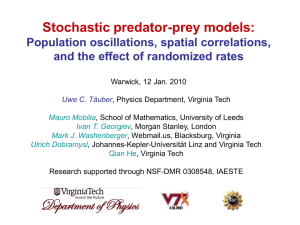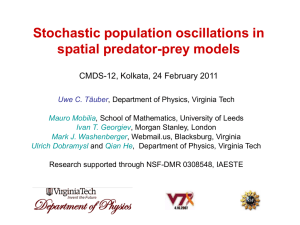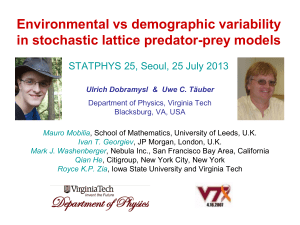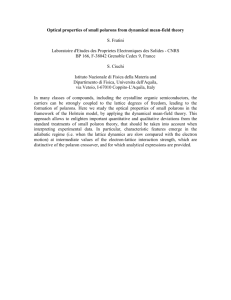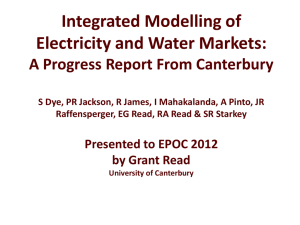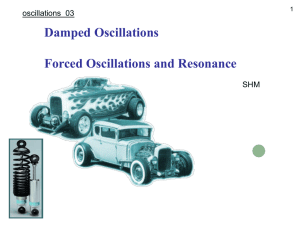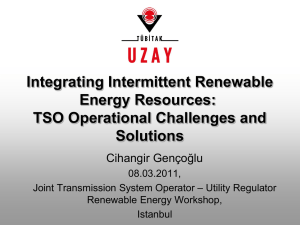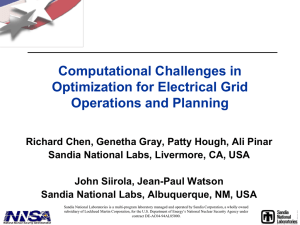Stochastic fluctuations and emerging correlations in simple
advertisement
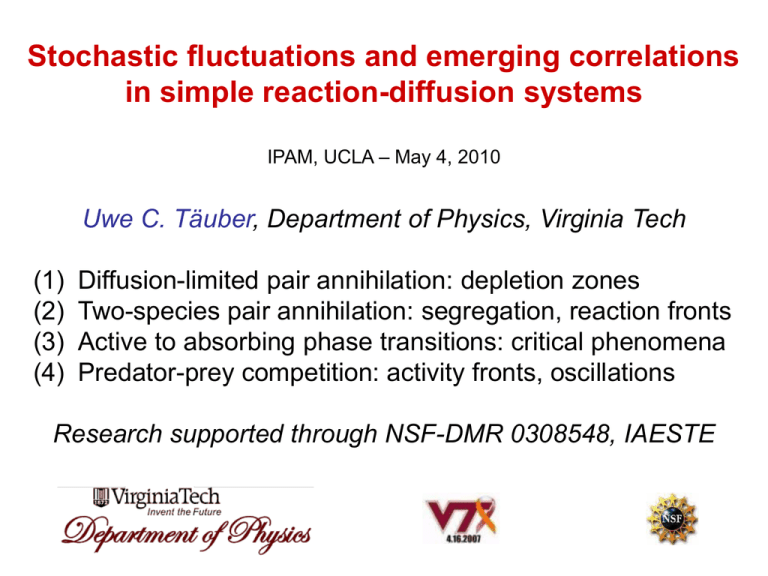
Stochastic fluctuations and emerging correlations
in simple reaction-diffusion systems
IPAM, UCLA – May 4, 2010
Uwe C. Täuber, Department of Physics, Virginia Tech
(1)
(2)
(3)
(4)
Diffusion-limited pair annihilation: depletion zones
Two-species pair annihilation: segregation, reaction fronts
Active to absorbing phase transitions: critical phenomena
Predator-prey competition: activity fronts, oscillations
Research supported through NSF-DMR 0308548, IAESTE
Reaction-diffusion systems
Particles (e.g., on d-dimensional lattice), subject to:
• nearest-neighbor hopping → diffusive transport
• upon encounter: reactions Σ m i A i ↔ Σ n kA k
i
k
with specified rates (not necessarily in equilibrium)
→ effective models for many stochastic processes describing
complex cooperative non-equilibrium phenomena
chemical kinetics, population dynamics, but also:
domain wall kinetics, epidemic and opinion spreading …
– spatial fluctuations non-negligible
– internal reaction noise prominent
– dynamical correlations crucial
(1) Diffusion-limited pair annihilation
A + A → 0 (inert state), rate λ, irreversible
particle number: n = 0,1,2,…; n = 0 special: absorbing state
Master equation: ∂t Pn(t) = λ [(n+2)(n+1) Pn+2 (t) – n(n-1) Pn (t)]
moments: <nk(t)> = Σn nk Pn (t) → ∂ t<n(t)> = –2λ <[n(n-1)](t)>
mean-field approximation: factorize <[n(n-1)](t)> ≈ (<n(t)>) 2
→ rate equation: ∂t <n(t)> ≈ –2λ (<n(t)>) 2
solution: <n(t)> = n(0) / [1 + 2λ n(0) t] → 1/(2λ t) as t → ∞
add diffusion; in low dimensions: depletion zones emerge
o oo
o
oo
o
surviving particles
↓t
anti-correlated
o
o ← L(t) → o
scaling argument: L(t) ~ (2D t)1/2 → n(t) ~ 1/L(t) d ~ 1/ (D t) d/2
→ slower than 1/t in dimensions d<2: random walk recurrent
mathematical description:
•
Smoluchowski theory (1916)
solve diffusion equation with
appropriate boundary conditions
•
operator representations
- bosonic non-Hermitian “quantum”
many-particle system (Doi / Peliti)
→ coherent-state path integrals,
dynamical renormalization group
→ critical dimension for k A → 0:
d > d c = 2 / (k-1): mean-field scaling
d < d c : λ eff (t) ~ t -1+d/d c , n(t) ~ t -d/2
- mapping to quantum spin chains
→ bosonization, Bethe ansatz, …
•
tools specific to one dimension
empty-interval method, integrability, …
→ exact results (density, correlations)
pair annihilation: k = 2
d < 2 : n(t) ~ (D t) -d/2
d = 2 : n(t) ~ (D t) -1 ln(D t)
d > 2 : n(t) ~ (λ t) -1
triplet annihilation: k = 3
d = 1 : n(t) ~ [(D t)-1ln(D t)]
d > 1 : n(t) ~ (λ t) -1/2
1/2
(2) Two-species pair annihilation
A + B → 0 (inert state), rate λ, irreversible
conservation law: n (x,t) – n (x,t) = const → diffusive mode
A
B
rate equation: ∂ t<nA/B(t)> ≈ –λ <nA (t)> <nB (t)>
• n A(0) - n B(0) = n A(∞) > 0 : initial densities different
d > 2 : n B (t) ~ exp{– λ [n A(0) – nB(0)] t} ~ n A(t) – nA(∞)
d/2
d < 2 : ln n (t) ~ – (D t)
; d = 2 : ln n B(t) ~ – t / ln(D t)
B
• n A(0) = n B(0) : initial densities equal
spatial inhomogeneities grow ~ L(t)d/2
→ species segregation, nA/B(t) ~ (D t)-d/4
slower than 1/ t for d < d seg = 4
sharp reaction fronts separate domains
•
correlated initial conditions: … A B A B A B …
→ ordering preserved in d = 1, scaling as for A + A → 0
Generalization: q-species pair annihilation
A +A →0, 1≤i<j≤q
i
j
no conservation law for q > 2, dseg = 4 / (q–1)
symmetric case: equal rates, n (0)
i
• d ≥ 2 : as A + A → 0 (clear for q → ∞)
confirmed by Monte Carlo simulations
effective exponent: α(t) = - d ln n(t) / d ln t
• d = 1 : species segregation
-1/2
-α(q)
density: n(t) ~ t
+ct
, α(q) = (q–1) / 2q
domain width: w(t) ~ t β(q) , β(q) = (2q–1) / 4q
d=1
d=2
(1000 x 1000)
special initial state:
e.g., … ABCDABCD …
d=1
(100000)
H. Hilhorst, O. Deloubriere, M.J. Washenberger, U.C.T., J. Phys. A 37 (2004) 7063
(3) Active to absorbing phase transitions
reactions (+ diffusive transport)
σ
A→
A+A , A →μ 0 , A+A →λ A
reaction-diffusion (rate) equation:
∂t n(x,t) = D (∆ – r) n(x,t) – λ n(x,t) 2
→ phase transition at r = (μ–σ) / D
→t
continuous active / absorbing transition:
∂t n(x,t) = D ∆ n(x,t) + R[n(x,t)] + ς(x,t)
DP cluster:
2
reactions: R[n] = – r n – λ n + …
Langevin noise: < ς(x,t) > = 0 ,
< ς(x,t) ς(x’,t’) > = L[n] δ(x-x’) δ(t-t’)
absorbing state: L[n] = σ n + … Critical exponents (ε = 4-d expansion):
→ directed percolation (DP)
universality class, dc = 4
(H.K. Janssen 1981; P. Grassberger 1982)
(4) Lotka-Volterra predator-prey competition
• predators: A → 0 death, rate μ
• prey:
B → B+B birth, rate σ
• predation: A+B → A+A, rate λ
mean-field rate equations for
homogeneous densities:
da(t) / dt = - µ a(t) + λ a(t) b(t)
db(t) / dt = σ b(t) – λ a(t) b(t)
a* = σ / λ , b* = μ / λ
K = λ (a + b) - σ ln a – μ ln b
conserved → limit cycles,
population oscillations
(A.J. Lotka, 1920; V. Volterra, 1926)
Model with site restrictions (limited resources)
mean-field rate equations:
da / dt = – µ a(t) + λ a(t) b(t)
db / dt = σ [1 – a(t) – b(t)] b(t)
– λ a(t) b(t)
“individual-based” lattice
Monte Carlo simulations:
σ = 4.0 , μ = 0.1 , 200 x 200 sites
• λ < μ: a → 0, b → 1;
absorbing state
• active phase: A / B coexist,
fixed point node or focus →
transient erratic oscillations
• prey extinction threshold:
active / absorbing transition
expect DP universality class
(A. Lipowski 1999; T. Antal, M. Droz 2001)
finite system in principle always
reaches absorbing state, but survival
times huge ~ exp(cN) for large N
Predator / prey coexistence:
Stable fixed point is node
Predator / prey coexistence:
Stable fixed point is focus
Oscillations near focus: resonant
amplification of stochastic fluctuations
(A.J. McKane & T.J. Newman, 2005)
Population oscillations in finite systems
(A. Provata, G. Nicolis, F. Baras, 1999)
oscillations for large system:
compare with mean-field expectation:
Correlations in the active coexistence phase
M. Mobilia, I.T. Georgiev, U.C.T., J. Stat. Phys. 128 (2007) 447
abandon site occupation restrictions :
M.J. Washenberger, M. Mobilia, U.C.T., J. Phys. Cond. Mat.19 (2007) 065139
stochastic Lotka-Volterra model in one dimension
• no site restriction:
σ = μ = λ = 0.01: diffusion-dominated
σ = μ = λ = 0.1: reaction-dominated
• site occupation restriction:
species segregation;
effectively A+A → A
-1/2
a(t) ~ t → 0
Effect of spatially varying reaction rates
• 512 x 512 square lattice, up to 1000 particles per site
• reaction probabilities drawn from Gaussian distribution,
truncated to interval [0,1], fixed mean, different variances
a(t)
•
•
•
•
|a(ω)|
stationary predator and prey densities increase with Δλ
amplitude of initial oscillations becomes larger
Fourier peak associated with transient oscillations broadens
relaxation to stationary state faster
U. Dobramysl, U.C.T., Phys. Rev. Lett. 101 (2008) 258102
Triplet “NNN” stochastic Lotka-Volterra model
“split” predation interaction into two independent steps:
A 0 B → A A B , rate δ; A B → 0 A , rate ω
- d > 4: first-order transition (as in mean-field theory)
- d < 4: continuous DP phase transition, activity rings
Introduce particle exchange, “stirring rate” Δ:
- Δ < O(δ): continuous DP phase transition
- Δ > O(δ): mean-field scenario, first-order transition
M. Mobilia, I.T. Georgiev, U.C.T., Phys. Rev. E 73 (2006) 040903(R)
Cyclic competition: “rock-paper-scissors game”
A+B → A+A , B+C → B+B , A+C → C+C
well described by rate equations:
species cluster, transient oscillations
fluctuations and disorder have little effect
Q. He, M. Mobilia, U.C.T., in preparation (2010)
Conclusions
• stochastic spatial reaction-diffusion systems:
models for complex cooperative non-equilibrium phenomena
• internal reaction noise, emerging correlations often crucial:
- depletion zones (anticorrelations) → renormalized rates
- species segregation, formation of reaction fronts
- active to absorbing state transitions: DP universality class
- fluctuations can stabilize spatio-temporal structures
• stochastic spatial systems may display enhanced robustness
• deviations from mean-field rate equation predictions:
- qualitative: in low dimensions d < d c , d = 1 usually special
- quantitative: potentially always…
how do we know → criterion ?
